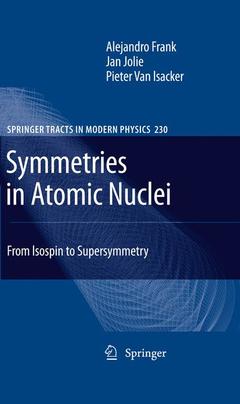Description
Symmetries in Atomic Nuclei, 2009
From Isospin to Supersymmetry
Springer Tracts in Modern Physics Series, Vol. 230
Authors: Frank Alejandro, Jolie Jan, van Isacker Pieter
Language: English
Keywords
Bose-Fermi symmetr; Bose-Fermi symmetries; Boson; Dynamical symmetry breaking; Isospin; Neutron; Quantal Many-Body Systems; Supersymmetry Neutrons Protons; Supersymmetry quantum mechanics; Symmetry Nuclear Physics; hoyingf; mixed-symmetry states; strings and superstrings; supersymmetry examples; two-nucleon transfer reactions
Publication date: 11-2010
· 15.5x23.5 cm · Paperback
Replaced by new edition: Access to the new edition.
Publication date: 12-2008
185 p. · 15.5x23.5 cm · Hardback
Replaced by new edition: Access to the new edition.
Description
/li>Contents
/li>Biography
/li>Comment
/li>
Symmetries in Atomic Nuclei aims to present an overview of recent applications of symmetry to the description of atomic nuclei. Special care is given to a pedagogical introduction of symmetry concepts using simple examples. After a historical overview of the applications of symmetry in nuclear physics, progress in the field during the last decade is reviewed. Special emphasis is put on the introduction of neutron-proton and boson-fermion degrees of freedom. Their combination leads to a supersymmetric description of pairs and quartets of nuclei.
Both theoretical aspects and experimental signatures of dynamical (super)symmetries are carefully discussed. Case studies show how these symmetries are displayed by real atomic nuclei which have been studied experimentally using state-of-the art spectroscopy. This book focuses on nuclear structure physics and has been written by active investigators in the field, but its scope is wider and is intended for final-year or post-graduate students and researchers interested in understanding the power and beauty of symmetry methods in physics.
The authors have for decades worked on the applications of symmetries in nuclear, molecular, and other areas of physics. They were actively involved in the theoretical introduction of supersymmetry in nuclear physics.
Jan Jolie became an experimental physicist and subsequently performed several crucial experiments to test the applications of supersymmetry in atomic nuclei. For this work he was awarded the Leigh-Page Prize 2000 by Yale University.
Alejandro Frank is a Fellow of the American Physical Society and has received several distinctions including a Guggenheim Fellowship.
Piet Van Isacker is a member of the Mexican Academy of Science and has written two previous books on the application of symmetry methods to nuclear physics.




